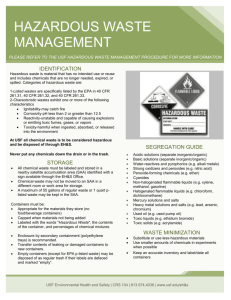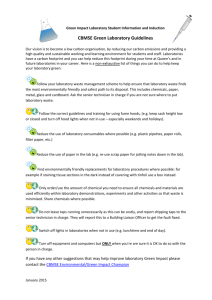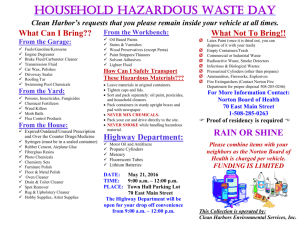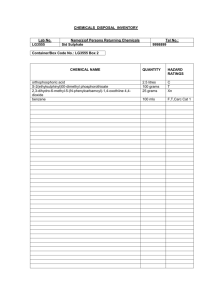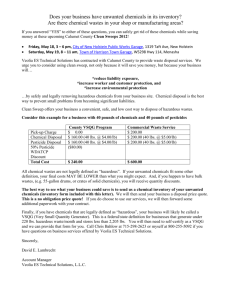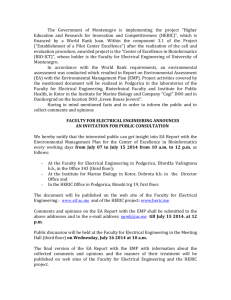International Best Practice in Safety of Research Laboratories
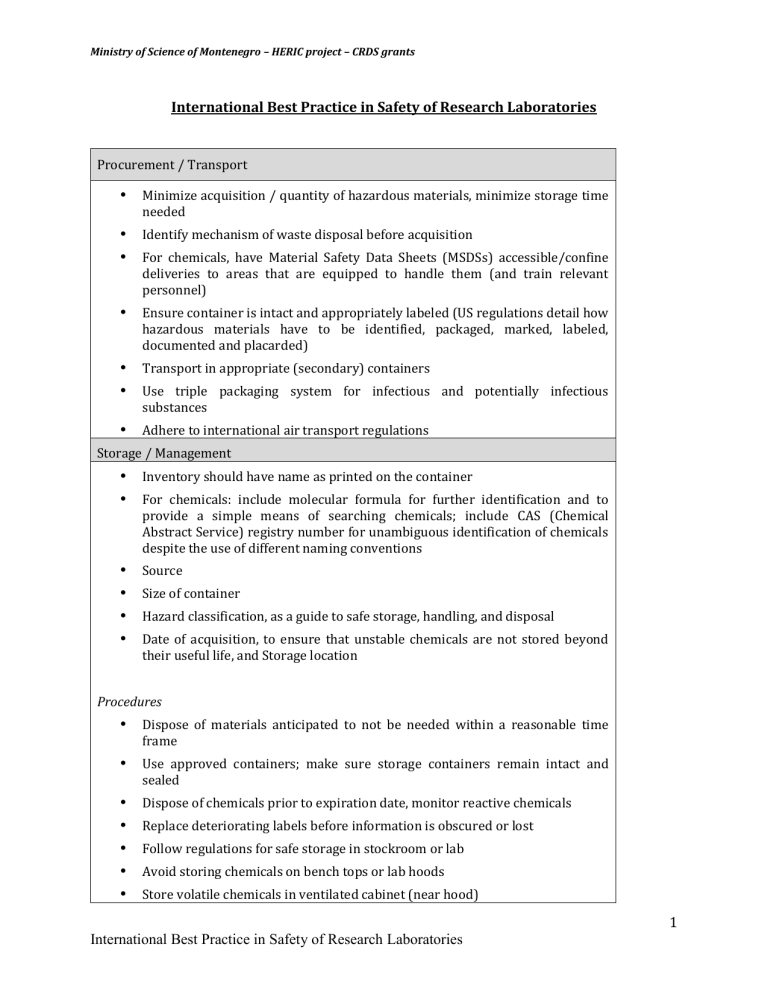
Ministry of Science of Montenegro – HERIC project – CRDS grants
International Best Practice in Safety of Research Laboratories
Procurement / Transport
Minimize acquisition / quantity of hazardous materials, minimize storage time needed
Identify mechanism of waste disposal before acquisition
For chemicals, have Material Safety Data Sheets (MSDSs) accessible/confine deliveries to areas that are equipped to handle them (and train relevant personnel)
Ensure container is intact and appropriately labeled (US regulations detail how hazardous materials have to be identified, packaged, marked, labeled, documented and placarded)
Transport in appropriate (secondary) containers
Use triple packaging system for infectious and potentially infectious substances
Adhere to international air transport regulations
Storage / Management
Inventory should have name as printed on the container
For chemicals: include molecular formula for further identification and to provide a simple means of searching chemicals; include CAS (Chemical
Abstract Service) registry number for unambiguous identification of chemicals despite the use of different naming conventions
Source
Size of container
Hazard classification, as a guide to safe storage, handling, and disposal
Date of acquisition, to ensure that unstable chemicals are not stored beyond their useful life, and Storage location
Procedures
Dispose of materials anticipated to not be needed within a reasonable time frame
Use approved containers; make sure storage containers remain intact and sealed
Dispose of chemicals prior to expiration date, monitor reactive chemicals
Replace deteriorating labels before information is obscured or lost
Follow regulations for safe storage in stockroom or lab
Avoid storing chemicals on bench tops or lab hoods
Store volatile chemicals in ventilated cabinet (near hood)
International Best Practice in Safety of Research Laboratories
1
Ministry of Science of Montenegro – HERIC project – CRDS grants
If ventilation is not required, store in closable cabinet or on shelf with lip to prevent sliding
Do not expose stored chemicals to heat or direct sunlight
Observe all precautions regarding the storage of incompatible chemicals
Provide vented cabinets beneath hoods for storing hazardous materials
Use chemical storage refrigerators for storing chemicals
Have fire protection system (sprinklers)
Follow storage limits for flammable and combustible liquids
Restrict access to storage facility
Protocols / Facilities for Use in Research
Wear and use appropriate personal protection materials to minimize exposure
Wash hands
Reduce the possibility of creating splashes or aerosols
Contain in biological safety cabinets operations that generate aerosols
Use good housekeeping
Use mechanical pipetting devices
Promptly decontaminate work surfaces
Never eat, ring, smoke, handle contact lenses, apply cosmetics, or take medicine in the lab
Take special care when using sharps
Keep lab doors closed when experiments are in progress
Use secondary leak-proof containers to move or transfer cultures
Decontaminate infectious waste before disposal
Post appropriate warning signs
Mark emergency equipment, maintain it, inspect it; list telephone numbers to call in case of accident
Control access
For Radioisotopes
Use only in designated areas
Allow the presence of essential staff only
Use personal protective equipment
Monitor personal radiation exposures
Use spill trays lined with disposable absorbent materials
Limit radionuclide quantities
Shield radiation sources
International Best Practice in Safety of Research Laboratories
2
Ministry of Science of Montenegro – HERIC project – CRDS grants
Mark radiation containers with the radiation symbol, including radionuclide identity, activity, and assay date
Use radiation meters to monitor working areas, protective clothing, and hands after completion of work
Use appropriately shielded transport containers
Remove radioactive waste frequently from the working area
Maintain accurate records of use and disposal of radioactive materials
Screen dosimetry records for materials exceeding the dose limits
Establish and regularly exercise emergency response plans
In emergencies, assist injured persons first
Clean contaminated areas thoroughly
Write and keep incident reports
For Animal laboratories
Require good microbiological techniques
Establish policies and protocols for all operations and for access to vivarium
Establish appropriate medical surveillance program and supervision for staff
Prepare and adopt safety or operations manual
Post warning signs
Decontaminate work surfaces after use
Use appropriate biological safety cabinets or isolator cages; handle and decontaminate animal bedding and waste materials appropriately
Transport material for autoclaving or incineration safely, in closed containers
Treat, report, and record injuries
Training of Personnel
Employer develops Chemical Hygiene Plan containing (models available from U.S. government and from some professional societies)
Employee information and training about the hazards of chemicals in the work area: o How to detect their presence or release o Work practices and how to use protective equipment o Emergency response procedures
Circumstances under which a lab operation requires prior approval from the
International Best Practice in Safety of Research Laboratories
3
Ministry of Science of Montenegro – HERIC project – CRDS grants institution
Standard operating procedures for work with hazardous chemicals
Criteria for use of control measures
Measures to ensure proper operation of fume hoods and other protective equipment
Provisions for additional employee protection for work with select carcinogens and toxins
Provisions for medical consultations and examinations for employees
Labs should establish their own safety groups at the department level (include students and support staff)
Labs should provide training in safety and waste management for all lab workers, including students in laboratory classes
Labs should incorporate institutionally supported lab and equipment inspection programs into their overall health and safety programs
Review exit / evacuation routes
Know how to report fire, injury, chemical spill, or summon emergency response
Know first aid
Know location and use of emergency equipment such as safety showers and eyewashes
Know location and use of fire extinguishers and spill control equipment (have appropriate kits readily available)
Lab personnel should establish ongoing relationships and clear lines of communication with emergency response teams
Include information on safe methods for highly hazardous procedures commonly encountered by lab personnel that involve: o Inhalation risks o Ingestion risks o Risks of percutaneous exposures o Bites and scratches when handling animals o Handling of blood and other potentially hazardous pathological materials o Decontamination and disposal of infectious material
Segregation / Triage of Waste
Multihazardous waste – goal is reduction of waste to a waste that presents a single hazard.
Consider frequency and amount of waste generated; assess risk
Identify / characterize waste: o Physical description
International Best Practice in Safety of Research Laboratories
4
Ministry of Science of Montenegro – HERIC project – CRDS grants o Water reactivity o Water solubility o pH and possibly neutralization information o ignitability / flammability o presence of oxidizer o presence of sulfides / cyanides o presence of halogens o presence of radioactive materials o presence of biohazardous materials o presence of toxic constituents
Minimize waste’s hazards
Determine options for management of hazards
If appropriate, take steps to neutralize waste or render it nonhazardous
When possible, select a single management option
Establish procedures for dealing with unstable waste, or waste that requires special storage or handling
Store safely: o Designated room or facility modified to contain the waste (with ventilation and effluent trapping) o Protect workers o Minimize risk of fire or spill o Minimize radiation levels outside of area o Consider compatibility of materials being accumulated (e.g., aqueous and non-aqueous waste should be separated)
Give particular attention to the handling or cleaning of radioactive laboratory ware, and to the proper disposal of sharps.
o Non-contaminated (non-infectious) waste can be reused or recycled or disposed of as general waste o Contaminated (infectious) sharps – collect in puncture-proof containers fitted with covers and treated as infectious; autoclave if appropriate o Contaminated material for decontamination by autoclaving and thereafter washing and reuse or recycling o Contaminated material for direct incineration
Disposal
No activity should begin unless a plan for the disposal of hazardous waste has been formulated
International Best Practice in Safety of Research Laboratories
5
Ministry of Science of Montenegro – HERIC project – CRDS grants
Use appropriate disposal method for each category of waste
Use appropriate containers
Label and securely close waste containers
Separate wastes as appropriate
For low level radioactive waste, options include
Storage time for decay and indefinite on site storage,
Burial at a low-level radioactive waste site,
Incineration, or
Sanitary sewer disposal
For biological waste, options include
Disinfection
Autoclaving
For liquids, disposal in sanitary sewer; putrescible waste disposed of by incineration; needles and sharps require destruction, typically by incineration or grinding
Collection and storage of waste
At satellite area near lab: o should be clearly identified, ventilated if necessary o determine whether to recycle, reuse, or dispose o hold here for less than one year; when containment volume limits reached, move to central accumulation area – package appropriately
At central accumulation area: o separate according to compatibility, commingle solvents when appropriate o label clearly, store in appropriate containers o limit storage time to 90 days o (ensure that employees are trained to handle waste materials as well as contingency planning for emergencies) o When transporting, make provisions for spill control in case of accident; have internal tracking system to follow movement of waste o Ensure that all necessary records have been generated (Quantities and identification of waste generated and shipped; Documentation and analyses of unknown materials; Manifests for waste shipping as well as verification of waste disposal; Any other information required to
International Best Practice in Safety of Research Laboratories
6
Ministry of Science of Montenegro – HERIC project – CRDS grants ensure compliance and safety from long-term liability)
Disposal options: o Incineration – is method of choice for most wastes, but is most expensive o Normal trash – only where appropriate, must be clearly identified and appropriately labeled o Sanitary sewer – not commonly used; solutions must be aqueous and biodegradable, or low toxicity inorganics – make sure sewer doesn’t drain into water supply inappropriate for waste disposal, and make sure waste is highly diluted o Release to the atmosphere – not acceptable; fume hoods must have trapping devices to prevent discharge to atmosphere
If hazardous and non-hazardous wastes are mixed, entire waste volume must be treated as hazardous
Preparation for transport to a treatment, storage, and disposal facility (TSDF)
Waste generator must obtain assurance (in terms of documentation, permits, records) that provider is reliable
For infectious material
Decontaminate, autoclave, or incinerate in lab
Package appropriately (for incineration or for transfer to another facility for incineration)
Protect against hazards to others to those who might come in contact with discarded items
International Best Practice in Safety of Research Laboratories
7

